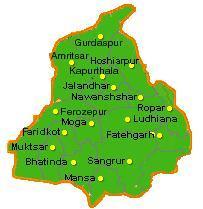Geographical Overview of Punjab
 The word Punjab consists of the two words “Panj” and “Aab” where Panj means five and Aab means water. This name was given to this region to symbolize its five rivers.
The word Punjab consists of the two words “Panj” and “Aab” where Panj means five and Aab means water. This name was given to this region to symbolize its five rivers.
The Northwest location of the state and its fertile land created a strong attraction for foreign influence. Persians, Arabs, the British, and Turko-Mongolians were a few of the groups which contributed to its development. Punjab also was a nurturing ground to several religious movements such as Buddism, Sikhism, and several schools of Islam.
The historical area of Punjab was defined to the east from the basin of the river Bias to the boundary of the river Indus to the west. On the north the state was bounded by the Kashmiri Himalayas and on the south it reached the plains of Rajasthan and Cholistan. However, over history Punjab has had its boundaries expand as well as shrink. The high time for Punjab occurred under the reign of Mugal emperor Babur and the empire of Maharaja Ranjit Singh. With the partition in 1947 the borders of the region shrank to its current size, with its division into the Pakistani province of Punjab and the Indian state of Punjab
Location:
Situated in the north-west of India, Punjab is bordered by Pakistan on the west, the Indian states of Jammu & Kashmir on the north, Himachal Pradesh on it’s nort-east and Haryana and Rajasthan on it’s south.
Area:
50362 square kilometers (Punjab occupies 1.54 % of the country’s total geographical area).
Capital:
Chandigarh (population: 642,0000)
Population:
23.51 million (P) for the year 1999
Rural: 16.56 million (70.45 )%
Urban: 6.95 million (29.55 )%
The population of Punjab consists mainly of Punjabis and Rajputs.
Occupation:
More than 80 percent of Punjab is cultivated, and farming is the leading occupation. The major crops are wheat, maize (corn), rice, pulses (legumes), sugarcane, and cotton. Among the livestock raised are buffalo and other cattle, sheep, goats, and poultry. The principal industries include the manufacture of textiles, sewing machines, sporting goods, starch, fertilizers, bicycles, scientific instruments, electrical goods, and machine tools, and the processing of sugar and pine oil.
Languages:
The official language is Punjabi, which is spoken by about two-thirds of the population. Many people are fluent in Hindi, English and Urdu also.
Currency:
Rupee (100 paise equals one rupee)
State Animal:
Black Buck – Locally called kala hiran, the Black Buck is a graceful antelope blessed with a striking colour and spiraled horns. The fawn’s coat is yellowish but it becomes turns black at maturity. It is found in the plains and avoid forests and hilly tracks. Mostly found in herds of 20-30, large herds may number several hundreds. With a keen eyesight and speed, it responds to alarm call by leaps and bounds.
State Bird:
Baz (Eastern Goshawk)
State Tree:
Shisham
Geography:
Find Punjab on the globe at 29’30’’ N to 32’32’’ N latitude and 73’55 E to 76’50 E longitude. Punjab lies between the Indus and the Ganges rivers. Most of the state is an alluvial plain irrigated by canals. Punjab’s arid southern border edges on the Thar or Great Indian Desert. The Siwalik Range rises sharply in the north of the state. The average temperature in January is 13° C (55° F), although at night the temperature sometimes lowers to freezing point. In June, the average temperature is 34° C (93° F), occasionally rising as high as 45° C (113° F). Annual average rainfall in Punjab ranges from 1250 mm (49 in) in the north to 350 mm (14 in) in the southwest. More than 70 percent of the annual rainfall occurs during the monsoon season i.e., from July to September.
Climate:
Climatically the state has three major seasons – summer, winter and rainy season.
Major Land Features:
Most of Punjab is a fertile plain; toward the southeast one finds semi-arid and desert landscape; a belt of undulating hills extends along the northeast at the foot of the Himalayas. Four rivers, the Ravi, Beas, Satluj and Ghaggar flow across the state in a southwesterly direction. They have numerous small and seasonal tributaries. In addition, Punjab is watered by an extensive canal system.